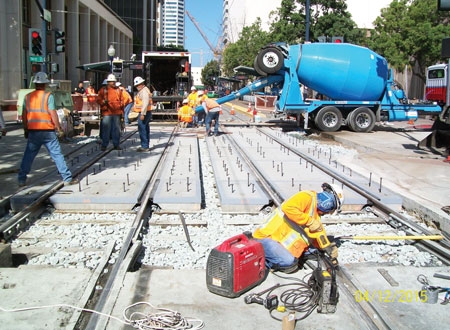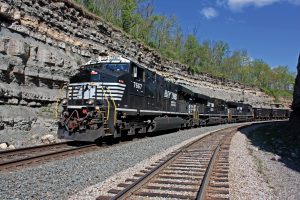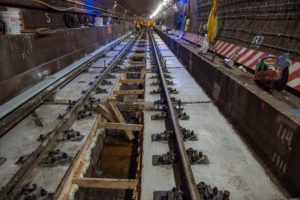Grade crossings: The annual report
Written by Jenifer Nunez, assistant editor
Whether they are made up of concrete, rubber or another substance, grade-crossing surface suppliers continue to make safety a top priority.
{besps}May15_crossings{/besps} {besps_c}0|1crossings.jpg| An Omega crossing system being installed on a SANDAG project.{/besps_c} {besps_c}0|2crossings.jpg| A finished Century Group crossing already in service.{/besps_c} {besps_c}0|3crossings.jpg| HiRAIL’s full-depth rubber gauge panel being lagged down to the tie.{/besps_c} {besps_c}0|4crossings.jpg| Oldcastle Precast’s concrete crossing system being lowered into position.{/besps_c} {besps_c}0|5crossings.jpg| Omni’s concrete and rubber crossing materials being lowered in place to connect road and rail.{/besps_c} {besps_c}0|6crossings.jpg| LT Resources’ Endurance Composite Crossing being installed.{/besps_c}{besps_c}0|7crossings.jpg| American Concrete.{/besps_c}
Whether they are made up of concrete, rubber or another substance, grade-crossing surface suppliers continue to make safety a top priority.
Grade crossing surface suppliers are focusing on custom manufacturing, as well as ease of installation and maintenance by offering the most innovative surfaces and materials to date.
American Concrete and Enterprise Concrete
American/Enterprise Concrete Products now offers a precast crossing for concrete tie manufacturer Rail One with panels that the company says have a unique configuration on the bottom to fit this specific tie.
Additionally, American/Enterprise Concrete Products manufactures panels for any length of tie and any tie spacing. The company supplies eight-foot and one-and-a-half-inch, nine-foot and 10-foot long panels that are manufactured with a non-slip surface that is sealed to prevent ion mitigation from salt and other chemicals.
Buz Hutchinson, railroad sales and service at the company, notes that transit and high-speed rail projects are being constructed at an all-time high pace and many new intermodal yard projects are bidding or being constructed now.
“With the high demand, the Class 1 railroads are turning over standardized, high quality product lines at ECP and ACP,” said Hutchinson. “The Class 1s are increasing their project planners to keep up with current and future work; they know to go with products they can trust and companies that can rapidly adapt to any changes that are presented.”
ECP and ACP combine to deliver a high quality, standardized crossing product that is in great demand with Union Pacific and BNSF and an expanding high-speed rail market, Hutchinson says.
“Although the oil-by-rail market has fallen off recently, the rail industry recognizes the current rail infrastructure is insufficient to meet future demand. Double and triple tracks are being added across the U.S. and our crossing business has dramatically expanded with this growth,” described Hutchinson.
ECP and ACP production facilities are AAR/M1003 and PCI Certified with all QC staff certified by these organizations. American/Enterprise Concrete Products has a PHD led Engineering Design and Drafting Department which can assist with any new concepts.
“A certification is one thing, but the ability to apply new knowledge, with tried and true quality processes, is what our people do for our products,” Hutchinson commented.
Century Group
Century Group, Inc., says it offers the convenience of prefabrication combined with the exactness of a custom-made product to provide long lasting grade-crossing panels to its customers.
Century Group has produced precast concrete grade-crossing panels for more than 25 years and has more than three decades of experience in the ownership and operation of a railroad construction company. The company has more than 65 years in precast concrete manufacturing and provides personnel who travel to project sites and assist customers in the design, development and manufacturing of grade crossing systems.
The company offers panels for numerous rail sizes with features, such as custom surfaces to match color and textured paving at passenger station platforms and sidewalks. Century Group also offers the option of providing crossties with its crossing surfaces and specializes in custom manufacturing for various rail configurations, such as turnouts, curves, crossovers, diamonds, wide/narrow gauge, extreme loads, pedestrian and ADA crossing applications, says Jerry McCombs, vice president of Century Group’s Railroad Products Division.The company also offers a system that incorporates an interface for asphalt on the field side, while utilizing standard panels for the gauge area.
Century Group’s manufacturing facilities are certified by the National Precast Concrete Association. McCombs says the certification of the company’s manufacturing facilities demonstrates Century’s commitment to the highest of standards in all areas of production, safety and information management.
“We continue to batch/mix all of our own concrete at our company-owned/operated facilities versus using ready-mix that some of our competitors use, combined with using grade 72 reinforcement versus grade 60,” said McCombs. “Using 12,000-psi stronger reinforcement combined with hands-on QA/QC from batching/mixing our own concrete and having certified welders, enables us to provide a high-quality product to the marketplace. Improved capacity and inventories at our manufacturing facilities allows us to continue to respond quickly to our customers’ needs.
HiRAIL
HiRAIL Corporation manufactures a complete line of rubber grade-crossing surfaces including Hi-Rail, Pede-STRAILTM and Hi-Rail Rail Seal (RS). HiRAIL says its full-depth rubber crossings are a green product, manufactured from recycled vehicle tires. The crossings can also be recycled at the end of their useful life.
HiRAIL full-depth rubber grade-crossing systems provide a smooth, safe and attractive crossing surface for motor vehicles, the company notes. They are manufactured to accommodate most common rail sizes, rail fastenings and wood, concrete or steel ties. HiRAIL full-depth rubber crossing systems are available in both lagged and lagless designs. The company says the lagless design lessens crosstie degradation, as well as allowing for installation on concrete and steel ties.
Pede-STRAIL is a pedestrian crossing surface that meets ADA requirements. Pede-STRAIL has all the features of HiRAIL full-depth rubber and comes with a raised diamond surface for pedestrian stability.
HiRAIL RS is a product that works in conjunction with asphalt or poured-in-place concrete crossings and is manufactured to fit most common rail sizes on timber or concrete ties using all types of rail fastening.
“So far, this year, the majority of our crossing material has been installed on Class 1 railroads,” explained Walt Barry, vice president. “This is most likely due to healthy maintenance budgets and large programs on the Class 1s.”
LT Resources
LT Resources, Inc., says it is best known for its ENDURANCE® Composite Crossings and its ENDURANCE-XL PLUS line of durable, recycled and recyclable polymer composite crossings. ENDURANCE-XL PLUS Composite Crossings can now be supplied in various colors and patterns to address the industry’s focus on improving safety at grade crossings.
LT Resources plans to introduce two new grade-crossing products utilizing improved technology and high-tech designs to complement ENDURANCE-XL PLUS crossings at Railway Interchange in Minnapolis, Minn.
“Both of these new designs are quite different from ENDURANCE-XL PLUS, but just as durable and cost-effective,” explained Linda Thomas, president.
ENDURANCE-XL PLUS crossings are manufactured using an engineered plastics formulation and can accommodate all mainline rail profiles and fastening systems.
“The end result is a durable, long-lasting grade-crossing product suitable for all types of traffic conditions,” said Thomas. “With built-in composite flangeway filler and lifting devices, the panels are quickly and easily installed due to a limited number of parts. Just lay them down, lag them down and go. Panels can be easily removed and replaced for track maintenance.”
In addition to on-going Class 1 new construction and maintenance, continued growth in manufacturing, port/intermodal facilities, oil and gas fracking and light-rail/commuter lines assures sustained demand for improved grade-crossing surface products, she notes.
Oldcastle Precast
Oldcastle Precast has worked with its railroad and contractor customers to produce custom StarTrack Crossing Systems for radius track with booted restraining rail and colored concrete.
All of the StarTrack surfaces are one-piece casting precast concrete modules, with anti-skid, diamond plate finishes, placed on a prepared subgrade with no ties. The 17-foot six-inch long StarTrack modules are designed for quick construction through long straight crossings or street running track applications.
“We continue to see transit agencies and freight railroads interested in installing crossing systems that can stand up to increasing vehicle and heavy truck traffic with little to no long-term maintenance,” explained Patrick Juelich, railroad product sales. “Crossing surface durability is only as good as it’s foundation and many crossings have poor soil conditions. These problem crossing areas can be solved through stabilizing the sub base, improving drainage and distributing loads over a larger area with our StarTrack crossing systems.”
Omega
“Class 1 maintenance budgets are at an all-time high this year, which translates into increased crossing panel demand from BNSF, Union Pacific, as well as Canadian Pacific,” explained Mark Mottola, national sales manager at Omega Industries, Inc. “Transit industry demand is also up with Amtrak, Bay Area Rapid Transit, Dallas Area Rapid Transit and San Diego Association of Governments crossing projects currently underway.”
Omega says it continues to build the “Main Line Common Standard” which is a shared BNSF/UP concrete panel design.
“The Common Standard is now the most widely used crossing design in the United States,” said Mottola.
The panels are 8.125-feet long and used on 10-foot hardwood ties spaced 19.5-inches on center. Frames are fabricated with 3-inch by 3-inch by 3/8-inch steel angle and the concrete mix is designed with 6,000 psi compressive strength. In addition, the panels are reinforced with two mats of #5 rebar and incorporate a pre-attached, non-conductive rubber filler. The panels are easily installed and secured to wood ties using 3/4-inch by 12-inch lag screws.
“Increased capacity at all four of our plants this year should allow us to maintain high inventory levels and reduce product lead times,” Mottola noted. “As always, we continue to strive for high quality, fast delivery, friendly customer service and one of the lowest failure rates in the industry.”
Omni
Omni Rail Products, Inc., offers a variety of grade-crossing solutions, including its TraCastTM tub-style crossing, which will soon feature a Pandrol “E” Clip fastening systems to secure the rail, the company reports. The TraCast crossing has a modular design with solid rubber rail interface; no crossties are necessary through the crossing.
The company also offers its Full-Depth Heavy Duty Rubber crossings, which it says are made from 100 percent virgin rather than recycled tires. It’s VRA Rail Seal is made from solid rubber rail interface molded to suit track structure (no voids) and has eight-inch tread coverage from ball of rail.
Omni’s ECR Concrete crossing has a one-piece design with rubber rail interface embedded into the concrete panel, which can be used on concrete or timber ties. Custom panels are designed for curves and turnout locations.
The Omni Improved Concrete crossing has panels with full-depth rubber rail interface on both sides of both rails. The molded gauge flangeway prevents debris from intruding into track structure. These can be ordered in combination with one piece ECR panels
“Contractors are exploring alternative tie materials, such as steel and plastic,” said Bob Cigrang, vice president of sales.
He also says that trends he has noticed are that concrete crossings are being ordered for narrow gauge and track with guard rails are being requested.
When it comes to high-speed rail, Omni says there are no modifications needed to its line of crossings.
Cigrang says a standard two-lane crossing can be laid in a matter of hours, which means Omni crossing panels maximize traffic volume and minimize the time crossings are closed for construction and maintenance.
Polycorp Ltd.
Polycorp Ltd. has developed a new Removable Railseal crossing system for use in concrete road surfaces and high-wear areas.
“The system allows the rubber railseal to be removed, repairs to be made and the rubber reinserted in a fraction of the time it takes for traditional repair work,” said Brad Bedford, technical sales coordinator. “This new design allows for overnight rail and fastener repairs to be made without costly detours and rush hour road closures.”
Polycorp manufactures products in the U.S. and Canada for every type of road surface, rail size and track construction, from traditional railseal to precast concrete panels. If required, Polycorp can supply Buy America products for all grade-crossing styles.
The rise in transit expansion has led Polycorp to develop a complete range of rail and special trackwork isolation products. The company’s patented TrackJacket Encapsulation System is comprised of a full line of products that work together to mitigate stray current and provide vibration isolation across the entire network.
“The rise in fuel costs throughout the world is taking people off the roads and onto the rails,” he explained. “This has resulted in an all-time high in transit ridership. This increased ridership has seen the payback shortened for transit expansion in major city centers leading to immediate launches of shovel-ready projects. Many of these expansion projects are utilizing Polycorp’s patented TrackJacket system for electrical and vibration isolation to improve their systems performance and reduce future maintenance with prolonged road and track life.”
Bedford notes that the continuing rise of freight tonnage has caused maintenance budgets to rise accordingly to keep the rail network running smoothly and avoid costly delays due to failures in the system. There has also been a significant increase in intermodal facility construction and maintenance to handle the increased year-over-year tonnage, he explains. This continuing growth has led Polycorp to develop a line of Epflex Railseal specifically tailored to ports and intermodal yards.
The company says the intricate track construction of high-speed rail requires a number of elastomeric products be used in the track structure and that these products facilitate vibration dampening inside the train, as well as the surrounding areas. Polycorp has refined its line of dynamic elastomeric track products for supply.
Stella-Jones
Stella-Jones Corporation supplies full-depth pressure-treated wood crossings to the rail industry.
George Caric, vice president of marketing says the 2015 demand has been strong in its Class 1 market segment, as well as the commercial sales and attributes this to a robust construction demand, as well as a strong tie program for the Class 1s.
“We see this demand remaining strong for the balance of the year,” he said. “Our new Russellville, Ark., facility is in full production and we are looking to add capacity as the demand dictates.”
TRANSPO INDUSTRIES
TRANSPO INDUSTRIES, Inc., is offering Color Safe® on panels cast in its Berwick, Pa., casting facility. Transpo Color Safe is an MMA-based material that provides high definition to the crossing and the optional use of reflective glass beads added to the Color Safe result in a high retro reflectivity crossing surface, the company notes. This product may also be applied to existing asphalt and concrete crossing surfaces resulting in what is being called the “dynamic envelope.” TRANSPO says Color Safe has a long service life and can easily be refreshed afteryears of service.
TRANSPO also offers its Bodan precast polymer concrete panel rail crossing system. Polymer panels are steel reinforced and the polymer concrete is more than three times stronger than standard concrete materials. The panels also have an integral high friction and wear resistant surface aggregate.
“This system does not conduct electricity, so it does not contribute to shunting,” said Rudy Gradishar, Midwest regional safety manager. “The system is designed to give long life at heavily traveled crossings. Expect eight to 10 years before minor maintenance is required, at which time the original panels can be reinstalled. Bodan is a bridge-type system that is supported by the rail not the crossties. Traffic load is transferred to the crossties, the same as loads from a train. With no attachment to the crosstie, Bodan will not contribute to deterioration of the crossties. Loose and jumping panels can be eliminated.”





